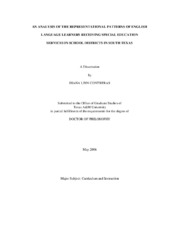| dc.description.abstract | This study examined the representational patterns of English language learners
receiving special education services in school districts in South Texas. Additionally, this
study identified school district characteristics that were related to the probability that an
English language learner might be placed in special education programs. Data were
collected from the Texas Education Agency'€™s Performance-Based Monitoring Analysis
System 2004-2005 and Academic Excellence Indicator System for the 2003-2004 school
year. Composition indices, risk indices, and relative risk ratios were calculated and
reported for each of the school districts in Education Service Centers I (Edinburg), II
(Corpus Christi), and XX (San Antonio) in the State of Texas (N=110). Pearson product-moment
correlation coefficients were calculated to determine the direction and strength
of the relationship among odds ratios and school district characteristics. These
characteristics included total student enrollment, percentage of poor/underserved
students, percentage of Latino students, percentage of English language learners, percentage of Latino teachers, and percentage of students in bilingual/English as a
second language programs.
Results indicated that English language learners in school districts in South
Texas were more than twice as likely as their non-English language learner counterparts
to receive special education services. Additionally, inverse relationships were
documented for odds ratios equal to or greater than 2.00 and the school district
characteristics of percentage of poor/underserved students, percentage of Latino students,
percentage of English language learners, percentage of Latino teachers, and percentage
of students in bilingual/English as a second language programs. It was concluded that
there was an overrepresentation of English language learners receiving special education
services in 77% (N=85) of the school districts in South Texas. | en |


